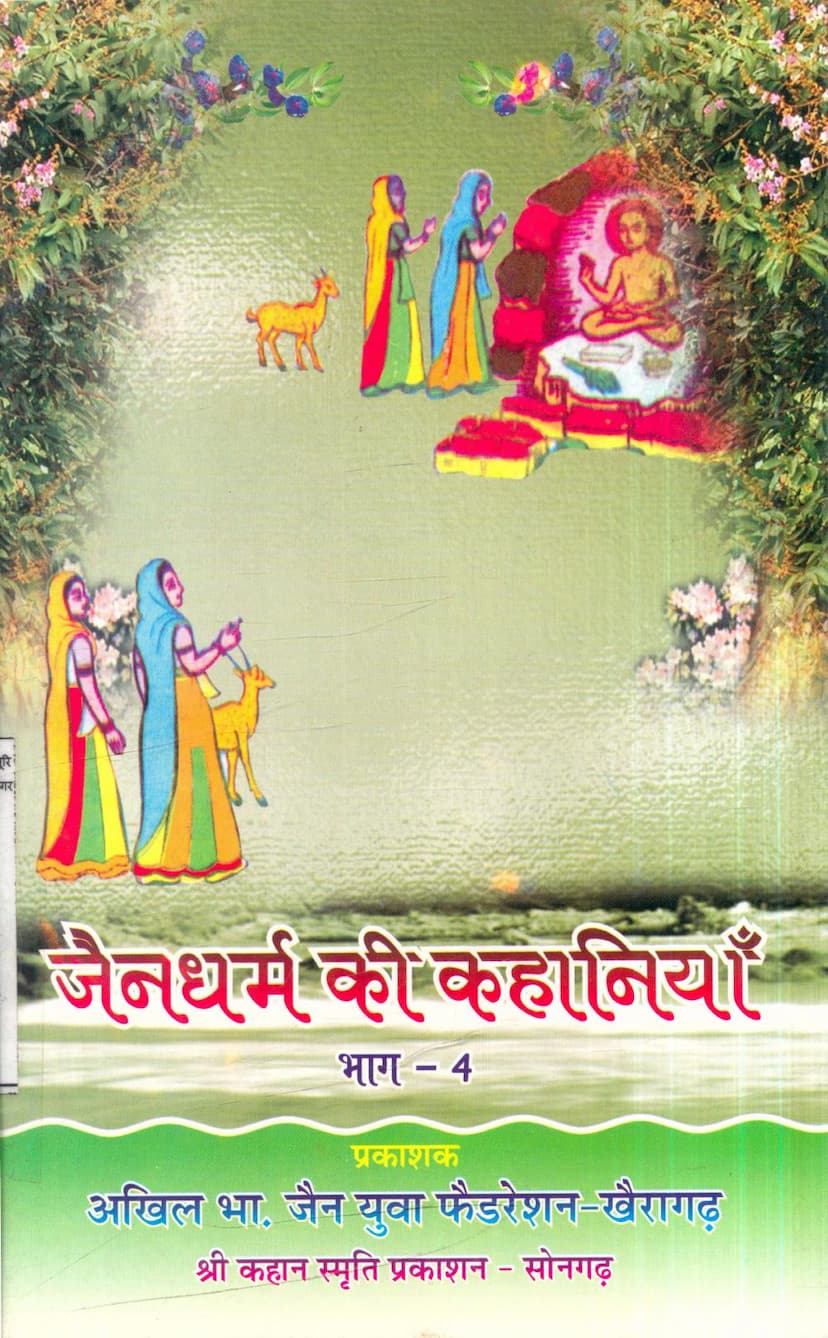Jain Dharm Ki Kahaniya Part 04
Added to library: September 1, 2025

Summary
This document is the fourth installment of "Jain Dharm Ki Kahaniya" (Stories of Jainism), published by Akhil Bharatiya Jain Yuva Federation. The book features two main narratives: the "Anjana Charitra" (The Life of Anjana) and "Lav-Kush Vairagya" (The Renunciation of Lav and Kush).
Key Information and Content Summary:
-
Authors/Translators/Editors: The book is written by Bra. Harilal Jain, translated by Sau. Swarnalata Jain, and edited by Pandit Rakesh Jain.
-
Publication: Published by Akhil Bharatiya Jain Yuva Federation, Khairagarh, and Shri Kahan Smriti Prakashan, Songadh.
-
Dedication/Support: The "Shri Dhudhibai Khemraj Gidia Granthamala" series, under which this book is published, was established with the blessings and support of Shri Khemraj Gidia. A brief biography of Shri Khemraj Gidia is included, highlighting his life, adherence to Brahmacharya, and contributions to Jain literature and temple construction.
-
Anjana Charitra (The Life of Anjana):
- Storyline: This narrative recounts the life story of Anjana Sundari, the daughter of King Mahendra. It details her arranged marriage to Pawan Kumar (also known as Pawananjay or Vayukumar), son of King Prahlad.
- Challenges: The story highlights the misunderstandings and conflicts that arise. A critical point is when Pawan Kumar overhears a conversation where Anjana's friend praises Pawan Kumar's rival, Vidyutprabh, leading Pawan Kumar to doubt Anjana's affection and decide to abandon her.
- Separation and Hardship: Pawan Kumar leaves Anjana, who, despite her purity and devotion, faces harsh treatment from her mother-in-law and abandonment by her father due to the accusations. She is forced to wander in the forest during her pregnancy.
- Spiritual Guidance and Divine Intervention: In the forest, Anjana encounters a Charana-Riddhi Siddha Muni who explains her past life karma and the reason for her suffering. She also receives protection from a Gandharva dev who takes the form of Ashta-pad to save her from a lion. A divine song sung by the Gandharva dev reassures her.
- Birth of Hanuman: Anjana gives birth to a powerful son, Hanuman (also named Shailkumar), in the forest. The miraculous circumstances of his birth and his divine strength are described.
- Reunion and Reconciliation: Anjana's maternal uncle, King Pratisurya, finds her and her son. The truth about her purity is revealed, leading to a reunion with Pawan Kumar, who had been searching for her. Pawan Kumar apologizes for his misunderstanding and mistreatment.
- Resolution: Anjana and Pawan Kumar are reunited, and Hanuman grows up to be a powerful and righteous prince. The story emphasizes the importance of understanding karma, forgiveness, and the power of devotion.
-
Lav-Kush Vairagya (The Renunciation of Lav and Kush):
- Context: This section is based on a discourse by Pujya Shri Kanji Swami about the liberation of Lav and Kush from Pavagarh Siddhakshetra.
- Storyline: The narrative focuses on the deep affection between Lord Rama and Lakshmana. Due to a divine test, Lakshmana dies of grief upon hearing a fabricated report of Rama's death.
- Rama's Grief and Devotion: Rama, though alive, mourns Lakshmana's death and carries his body, refusing to let go. This highlights the overwhelming nature of attachment.
- Lav and Kush's Renunciation: Witnessing their father's devotion and their uncle's death, Lav and Kush, the sons of Rama and Sita, develop a profound sense of renunciation (vairagya). They understand the impermanence of the world and the true nature of the soul.
- Seeking Permission for Diksha: They approach Rama for permission to take diksha (initiation into monkhood). Their speech emphasizes the desire for self-realization and liberation from the cycle of birth and death.
- Liberation at Pavagarh: Lav and Kush, along with other monks, achieve Kevalgyan (omniscience) and attain Moksha (liberation) from Pavagarh Siddhakshetra. The text highlights Pavagarh as a significant pilgrimage site due to the liberation of these noble souls.
- Spiritual Teachings: The discourse by Shri Kanji Swami emphasizes the importance of inner peace, self-realization, and the path to Moksha through the triple gem of Jainism (Samyakdarshan, Samyakgyan, Samyakcharitra). It underscores that true happiness lies within the soul, not in external circumstances or relationships.
-
Overall Message: The book aims to impart spiritual lessons through these stories, emphasizing the consequences of karma, the importance of understanding the soul's true nature, the power of devotion, the transient nature of worldly attachments, and the ultimate goal of liberation. It encourages readers to follow the path of righteousness and attain spiritual peace.
-
Publications: A list of other publications by the federation is also provided, showcasing their commitment to spreading Jain literature.
This summary provides a comprehensive overview of the content and spiritual teachings presented in "Jain Dharm Ki Kahaniya Part 04."